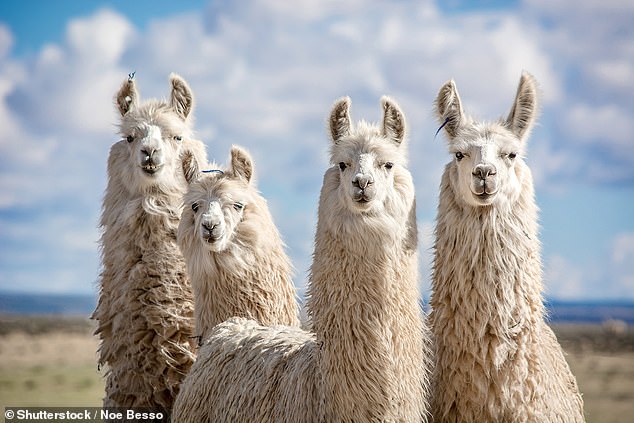

Coronavirus antibodies made by llamas could be administered to Covid-19 patients in the form of nasal sprays or asthma-style inhalers to help combat the disease.
Studies have shown that llama nano-bodies, made by the animals’ immune systems, are far more effective than their human equivalents at preventing illness and infection from Covid-19.
Lab experiments have showed that the nano-bodies adhere to the spike protein of SARS-CoV-2, the virus which causes Covid-19, effectively neutralizing it.
Researchers at the National Institutes of Health in Maryland have now isolated these nano-bodies from an individual llama named Cormac, in order to test their ‘therapeutic, preventative, and diagnostic potential’ in the fight against Covid-19.
Early indicators reveal the nano-bodies are effective in aerosol form, and can be administered to humans via nasal sprays or asthma-style inhalers.
The study was led by a pair of neuroscientists, Thomas J. “T.J.” Esparza, B.S., and David L. Brody, M.D., Ph.D., who work in a brain imaging lab at the NIH’s National Institute of Neurological Disorders and Stroke (NINDS).
“For years TJ and I had been testing out how to use nano-bodies to improve brain imaging. When the pandemic broke, we thought this was a once in a lifetime, all-hands-on-deck situation and joined the fight,” said Dr. Brody, who is also a professor at Uniformed Services University for the Health Sciences and the senior author of the study. “We hope that these anti-COVID-19 nano-bodies may be highly effective and versatile in combating the coronavirus pandemic.”
A nano-body is a special type of antibody naturally produced by the immune systems of camelids, a group of animals that includes camels, llamas, and alpacas. On average, these proteins are about a tenth the weight of most human antibodies. This is because nano-bodies isolated in the lab are essentially free-floating versions of the tips of the arms of heavy chain proteins, which form the backbone of a typical Y-shaped human IgG antibody. These tips play a critical role in the immune system’s defenses by recognizing proteins on viruses, bacteria, and other invaders, also known as antigens.
Because nano-bodies are more stable, less expensive to produce, and easier to engineer than typical antibodies, a growing body of researchers, including Mr. Esparza and Dr. Brody, have been using them for medical research. For instance, a few years ago scientists showed that humanized nano-bodies may be more effective at treating an autoimmune form of thrombotic thrombocytopenic purpura, a rare blood disorder, than current therapies.
Since the pandemic broke, several researchers have produced llama nano-bodies against the SARS-CoV-2 spike protein that may be effective at preventing infections. In the current study, the researchers used a slightly different strategy than others to find nano-bodies that may work especially well.
“The SARS-CoV-2 spike protein acts like a key. It does this by opening the door to infections when it binds to a protein called the angiotensin converting enzyme 2 (ACE2) receptor, found on the surface of some cells,” said Mr. Esparza, the lead author of the study. “We developed a method that would isolate nano-bodies that block infections by covering the teeth of the spike protein that bind to and unlock the ACE2 receptor.”
To do this, the researchers immunized Cormac five times over 28 days with a purified version of the SARS-CoV-2 spike protein. After testing hundreds of nano-bodies they found that Cormac produced 13 nano-bodies that might be strong candidates.
Initial experiments suggested that one candidate, called NIH-CoVnb-112, could work very well. Test tube studies showed that this nano-body bound to the ACE2 receptor 2 to 10 times stronger than nano-bodies produced by other labs. Other experiments suggested that the NIH nano-body stuck directly to the ACE2 receptor binding portion of the spike protein.
Then the team showed that the NIH-CoVnB-112 nano-body could be effective at preventing coronavirus infections. To mimic the SARS-CoV-2 virus, the researchers genetically mutated a harmless “pseudo virus” so that it could use the spike protein to infect cells that have human ACE2 receptors. The researchers saw that relatively low levels of the NIH-CoVnb-112 nano-bodies prevented the pseudo virus from infecting these cells in petri dishes.
Importantly, the researchers showed that the nano-body was equally effective in preventing the infections in petri dishes when it was sprayed through the kind of nebulizer, or inhaler, often used to help treat patients with asthma.
“One of the exciting things about nano-bodies is that, unlike most regular antibodies, they can be aerosolized and inhaled to coat the lungs and airways,” said Dr. Brody.
The team has applied for a patent on the NIH-CoVnB-112 nano-body.
“Although we have a lot more work ahead of us, these results represent a promising first step,” said Mr. Esparza. “With support from the NIH we are quickly moving forward to test whether these nano-bodies could be safe and effective preventative treatments for COVID-19. Collaborators are also working to find out whether they could be used for inexpensive and accurate testing.”
Senior author Professor David Brody said: ‘We hope these anti-Covid-19 nano-bodies may be highly effective and versatile in combating the coronavirus pandemic.’
Nano-bodies are naturally produced by the immune systems of camelids – animals that include camels, llamas and alpacas.
On average, the proteins are about a tenth the weight of most human antibodies and are also cheaper and easier to engineer.
Teams across the world, including Britain, have been harvesting llama nano-bodies that may help put the brakes on the pandemic.
Professor Brody and lead author Thomas ‘T.J’ Esparza say the one they have discovered – known as NIH-CoVnb-112 – is ten times stronger than any found to date.
(Daily Mail UK).





